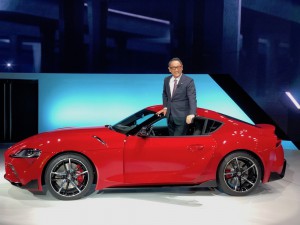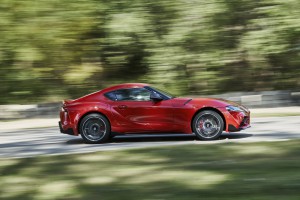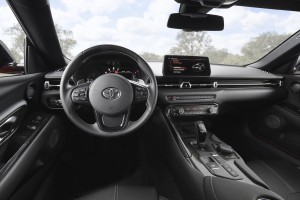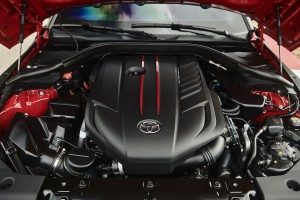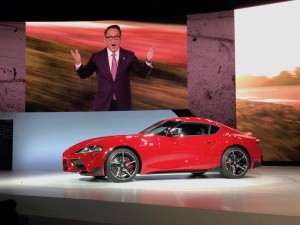
Toyota chief Akio Toyota welcomed back an "old friend," the new Toyota Supra at the North American International Auto Show in Detroit.
At a generally quiet 2019 North American International Auto Show one thing seems certain: there’ll be plenty of buzz as Toyota lifts the covers off the reborn Supra.
Though the automaker did tease us last year with a track version of the sports car, as well as a heavily disguised version of the street model during the summer at the Goodwood Festival of Speed, this is the first time most of the world will see it, sans camouflage, as the Toyota Supra makes its return after a 17-year global absence and a 21-year deficit in the U.S. market.
(We did get a sneak peek over the weekend, however, thanks to Toyota Mexico which issued a tweet declaring, “Our new #Supra arrived in Japan!, and this is the story that #AkioToyoda tells us about its return”, with an accompanying video profiling the sports car.)
Why take so long? For one thing, the Japanese automaker has had to cope with the harsh realities of a rapidly changing automotive market. In an era when SUVs and CUVs are rapidly replacing sedans, coupes and sports cars as the vehicles of choice Toyota knew it had a tough business case to make. It found a way to do that by teaming up with BMW which faced a similar dilemma as it sought a way to justify an all-new version of the recently launched Z4 roadster.
(Toyota makes it official: New Supra bows in Detroit. Click Here for the story.)
You may not hear much about the BMW connection from Toyota. It somehow managed to slip entirely out of the official press release describing the new Supra. But what we know is that the development efforts paired engineers from BMW and Toyota’s Gazoo Racing subsidiary. The Z4 and Supra share their underlying platform and a number of other components. But, unlike the virtually identical Toyota 86 and Subaru BRZ models, you won’t confuse them on the road.
It certainly helps that BMW has opted to retain the Z4’s roadster design while the new Toyota Supra will be offered in coupe configuration, with its styling heavily influenced by the wildly popular FT-1 concept Toyota revealed in Detroit in January 2014. But it also picks up on other old performance models with details like the double-bubble roof harkening back to the old Toyota 2000 GT.
Formally known as the Toyota GR Supra, a nod to the racing division, Toyota explains that, “Optimization of the FT-1 design onto the efficient, high-performance packaging of Supra was achieved by condensing the forms, reducing unnecessary elements and further enhancing the dynamic and powerful character (focusing) on core Supra attributes, such as its inline six-cylinder engine and rear drive layout, while enhancing other features, such as stretching the hood to highlight the engine, creating a taut, but spacious two-seat cabin that helps accentuate an ultra-wide stance.”
Internally, it adds, the Supra is being referred to as “Condensed Extreme.”
Inside, you’ll discover a low instrument panel with a large digital display creating a 3D-like gauge cluster. The cockpit-style layout places key controls atop the center console. In “base” trim, look for heated, leather-trimmed “racing inspired” seats, the buckets in the Premium model getting the Alcantara touch and power controls.
The 3.0 package also features a 6.5-inch display that can be operated by (any surprise?) an iDrive-like rotary controller. The 3.0 Premium upgrades to an 8.8-inch display that adds various telematics features, as well as the wireless version of Apple CarPlay, and a 12-speaker JBL audio system.
Add an assortment of advanced driver assistance technologies, including forward collision warning, automatic emergency braking with pedestrian detection, lane departure warning with steering assist, automatic high beam and road sign assist.
(Click Here for more about the Supra’s twin, the BMW Z4.)
When it goes on sale over the summer the 2020 Toyota Supra will be offered in two grades, the 3.0 and the 3.0 Premium – though there will be a limited-volume Launch Edition, as well.
Toyota boasts that the two-seater has achieved a 50:50 weight balance, with power going to the rear wheels. It comes from a 3.0-liter twin-scroll V-6 making 335 horsepower and 365 pound-feet of torque. By comparison, the BMW Z4 offers two engine options, a 255 hp 2.0-liter I-4, as well as a version of the turbo V-6 that makes 382 hp and 369 lb-ft.
Somewhat surprising, Toyota is expecting 0 to 60 times of around 4.1 seconds, while the more powerful BMW just manages to get there in 4.4 seconds. Credit – or blame, if you prefer – the heavier convertible top of the Bavarian entry, along with increased aero drag.
Both makers share an eight-speed automatic with paddle shifters. Sorry, friends of the manual, but as far as this collaboration is concerned, there’s no need for a stick shift. That clearly reflects both declining demand and the challenges the partners had in keeping the project within a tight budget.
High structural rigidity was a target for both manufacturers, and Toyota said it specified nine areas in the rear of the Supra “to be reinforced to increase rigidity.” It also set tough standards for suspension tuning and the sports car’s electronic stability control technology.
The new Supra features a double-joint spring strut front suspension and multi-link rear suspension. There are also two-mode variable dampers. As for steering, it’s both variable ratio and variable effort.
“Supra will come standard with 19-inch forged alloy wheels,” the automaker reveals. “The rear wheels and tires are wider than on the front (rear tires: 275/35R19; front tires: 255/35R19) to enhance grip, and performance Michelin Pilot Super Sport tires are fitted. Brakes are large at all four corners, highlighted by 13.7-in. front rotors held by 4-piston Brembo calipers.”
(To get details about Magna Steyr building the new Supra and Z4, Click Here.)
As for pricing, we’re hearing that the Toyota GR Supra 3.0 will come in at a starting price of $49,600. We’ll report more when we confirm that figure and the price of the Premium model.

